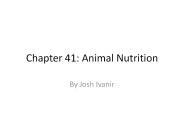Chapter 19: Digestion - PowerPoint PPT Presentation
1 / 21
Title:
Chapter 19: Digestion
Description:
Chapter 19: Digestion Chapter overview: Chapter 19 presents the physiology of digestion and nutrition, including: anatomical views and digestive parts identification – PowerPoint PPT presentation
Number of Views:181
Avg rating:3.0/5.0
Title: Chapter 19: Digestion
1
Chapter 19 Digestion
- Chapter overview
- Chapter 19 presents the physiology of digestion
and nutrition, including - anatomical views and digestive parts
identification - the process of digestion and absorption
- factors affecting digestibility of feeds
2
Digestion and Absorption
- The process of digestion includes
- The prehension of food or feed
- The mechanical chewing and grinding
- Mixing with digestive acids and enzymes to
chemically break down the foodstuffs - The process of absorption includes
- Transport of the digested foods across the
intestinal mucosa to the blood or lymph system
3
The General Mechanical Process
- Mastication - chewing
- Deglutition - swallowing
- Regurgitation - movement of digesta in reverse
order from the stomach to mouth - Defecation - voiding the fecal, or waste,
materials from the body
4
Animal Diet Types
- Species may be divided into dietary preference
groups - Herbivores consume plant materials, examples are
horses and cattle - Carnivores consume flesh of other animals,
examples are dogs and cats - Omnivores consume both plants and flesh, examples
include the primates
5
Differing Digestive Tracts
- Farm animal species have a variety of digestive
systems - Ruminants have four distinct stomach areas
- examples include bovine, ovine and caprine
- Nonruminants (also termed monogastrics) display
considerable variety - hogs, dogs, and cats have a single, simple
stomach - poultry have a two part stomach
- horses have a large, functional cecum
6
Nonruminant Digestive System
- Mouth - prehension and chewing of food some
carbohydrate enzyme activity - Esophagus - route of food from mouth to stomach
- Stomach - addition of hydrochloric acid and
protein digesting enzymes, mixing and holding
7
Nonruminant Digestive System
- Small intestine - primary site of digestion and
absorption - Large intestine - major site of water absorption
and preparation of digesta for excretion
8
Nonruminant Variations
- Poultry
- Mouth no teeth for chewing
- Esophagus a crop is contained within the
esophagus for food holding and moistening - Stomach divided into proventriculus (glandular
area) and ventriculus (crushing area) - Large intestine short and exiting into the
cloaca two large ceca with limited function
9
Nonruminant Variations
- Horse
- Large intestine differences
- cecum is very large (may contain 50 of digesta)
- cecum provides some nutrients to the horse via
microbial fermentation
10
Ruminant Digestive System
- Many parts of the tract are similar to
nonruminant monogastric description - Significant differences include
- Mouth contains no upper incisors
- Stomach is divided into four major parts
- rumen
- reticulum
- omasum
- abomasum
11
Ruminant Digestive System
- Rumen
- Largest digestive area of the compound stomach
- Majority of fermentation of feedstuffs occurs
here - Majority of absorption of byproducts of
fermentation - volatile fatty acids or VFAs
12
Ruminant Digestive System
- Reticulum
- Receives feed from esophagus
- Initiates mixing, regurgitation, and eructation
- Environment for fermentation of feedstuffs
13
Ruminant Digestive System
- Omasum
- Third area of the stomach receives the digesta
outflow of the rumen/reticulum - Some water absorption and further subdivision of
feed particles may occur
14
Ruminant Digestive System
- Abomasum
- The fourth and final stomach compartment, but
very similar in function to the pig stomach - Acid and enzyme stomach
- Final holding and mixing area before the small
intestine
15
Ruminant Digestive System
- Selected terms
- Regurgitation - controlled reverse movement of
coarse feedstuffs from reticulum/rumen via
esophagus to mouth for rechewing - Eructation - expulsion of accumulated
fermentation gases from rumen via esophagus - Rumination - refers to the processing of
feedstuffs in the reticulum/rumen, to include
fermentation, regurgitation, eructation
16
Chemistry of Digestion
- Digestion involves enzymes and acids produced by
the host animal or microbes working in symbiosis
with the host - Enzymes break specific chemical bonds in feeds
- Domestic animals produce enzymes to digest
nonfibrous carbohydrates, fats, and proteins - Only microbes have enzyme systems to digest
fibrous carbohydrates, such as cellulose
17
Digestion of Carbohydrates
- General carbohydrate digesting enzyme (amylase)
in the mouth begins digestion little amylase is
found in horses and none in ruminants - Carbohydrate digesting enzymes (amylase) from the
pancreas, and intestinal mucosa (sucrase,
maltase, lactase) complete carbohydrate digestion
18
Digestion of Proteins
- Protein digesting enzyme (pepsin) and
hydrochloric acid in the stomach begin
significant digestion - Protein digesting enzymes (e.g. trypsin) from the
pancreas and intestinal mucosa complete digestion
in the small intestine - Young nursing animals rennin coagulates milk
allowing more complete digestion
19
Digestion of Fat
- Fat digesting enzyme (lipase) in the stomach
begins digestion - Fat digesting enzymes from the pancreas (lipase)
and intestinal mucosa complete digestion in the
small intestine - To assist in fat digestion, bile from the liver
emulsifies fat into smaller droplets in the small
intestine
20
Factors Affecting Digestibility
- Rate of passage - in general, increased rate of
passage of digesta through the tract reduces
digestibility, factors increasing rate of passage
include - Increased level of feeding/intake (ruminants)
- Finer processing (such as grinding) of feed
- Note grinding grain usually increases
digestibility but grinding hay decreases
digestibility
21
Factors Affecting Conversion
- Feed conversion refers to the amount of
productivity per unit of feed consumed - Factors impacting feed conversion include
- Age/weight - younger animals are more efficient
- Level of feeding - limiting feed generally
increases efficiency - Inheritance - feed conversion is moderately
heritable correlation between ADG and efficiency
is high































